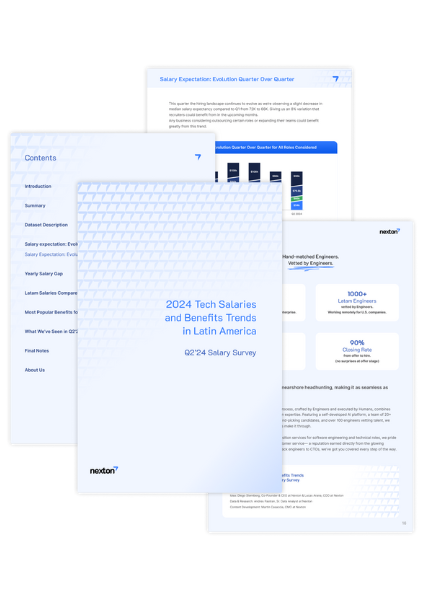Starting a new job anywhere can be tough. For new international and remote team members, the onboarding process can be even more intimidating, as they have to align with company goals from the solitude of their home office.
As you hire exciting new talent from Latin America and beyond, it’s essential to craft effective onboarding plans, so that your new hires start collaborating with your teams and making contributions from Day 1. In turn, robust onboarding lets your new remote employees feel connected and valued, aiding in your long-term retention strategy.
To help you out, we’ve put together a 30-, 60- and 90-day onboarding plan to ramp up your talent and achieve seamless team integration – no matter where in the world your tech talent is working from.
Why focus on onboarding?
Onboarding is absolutely crucial for orienting and engaging new hires in their roles. According to studies, 69% of employees are more likely to stick with a company for three years after experiencing great onboarding.
After all, onboarding is the new hire’s initial impression of the company. The better you integrate employees and align them with the company mission, the more connected and committed new hires will feel.
Some key benefits of excellent onboarding include:
- Adapting employees to the new environment quickly
- Boosting employee engagement
- Ramping up employee productivity
- Retaining new hires in the long term
- Tracking employee performance

Tips for onboarding new international remote team members
As we mentioned, international remote hires may have a larger hurdle to clear when starting a new role. Yet, your company can make this process seamless by considering these expert tips.
1. Make sure they have the support, resources and equipment they need
You may not see remote hires face-to-face every day, which is why it’s essential to check that they have the support, resources and equipment required to do the job. This includes access to collaboration platforms, coding depositories, intranet systems and anything else that’s part of your virtual office.
2. Set goals that are realistic and measurable
It’s important to set goals that are just right for your international team members. Be sure that they’re realistic for their skill and experience level, as well as measurable so that you can track improvement over time.
Often managers use the “SMART” goals method to pinpoint the right type of milestones. SMART – meaning Specific, Measurable, Attainable, Realistic and Time-bound – is a good rule of thumb for initial goal-setting.
3. Don’t forget about relationship goals
One often-overlooked aspect of onboarding is relationship-building. Make time for your new hire to meet team members, get to know them through activities and start collaborating with them.
A great way to ease this process is to assign an onboarding buddy to your remote hire, so that they can more easily be included in all team chats and events from the start.
4. Space out training sessions and spice them up
Avoid overloading your new hire with too many training sessions, especially if they’re not the most exciting in nature. Space them out and allow for other sorts of meetings and activities so it’s not too monotonous.
And remember: when top tech talent gets bored, nothing good happens. You’ll want to double-check that your new engineer isn’t sitting at home alone, slogging through dull onboarding activities. Try to make them as captivating as possible, space them out and have some challenging tasks or projects in mind for when your new hire quickly finishes onboarding milestones.
5. Pave the way for cultural alignment
Finally, cultural alignment should be a top priority for your new international hires. Focus on seamlessly integrating your new hire on your team and setting company culture expectations for communication, deadlines, quality standards, etc. This will help give them a sense of direction and pave the way for great team collaboration in the long run.

30-, 60- and 90-day onboarding plan
Outlining a 30-, 60- and 90-day onboarding plan will help your new international hire integrate into the team and ramp up their contributions ASAP. Instead of feeling aimless, your employee will feel empowered to meet weekly milestones and get a real sense of company expectations and mission.
30 days: Learning about the company product, policies, tools and culture
The 30-day period is typically quite hands-on and involves the employee getting familiar with the company product, policies, tools and culture. Small-scale goals may be set at this point in order to absorb onboarding materials, including:
- Learn about the company’s product, customers and sales funnel
- Undergo company-wide training on policies, culture and core values
- Get trained on company tools, platforms, intranet systems and more
- Meet with team members, customers, stakeholders, etc.
- Establish expectations and kick off job responsibilities
- Schedule check-in meetings to set and reset goals as needed
During this period, it's also key that your new hire achieves some quick wins and feels like a productive team member early on. To ensure a great experience in the 30-day period, be sure to assign some hands-on tasks as well, such as a code refactor or similar challenge. This will help boost morale and make your employee feel valued from the start.
60 days: Role-specific training and relationship building
During the 60-day period, employees will begin more role-specific training and relationship building, so that they can start making real contributions to the team goals. At this point, new hires are expected to implement their learnings from the 30-day milestones in order to:
- Set up regular feedback sessions with managers
- Address areas of improvement for job responsibilities
- Discuss opportunities to get more involved in team goals
- Actively participate in team meetings
- Deepen relationships with team members and customers
- Encourage autonomy through more robust goal-setting
90 days: Making key contributions independently
The 90-day period is all about allowing the new hire to take full responsibility of their role, with some accountability measures to provide feedback and realign as needed. Some typical milestones during this phase include:
- Take on responsibilities proactively and independently
- Make key contributions to team projects and goals
- Iron out any remaining issues with managers and direct reports
- Set new milestones for the rest of the year based on company KPIs
- Continue professional development through additional training, conferences, in-company mentorship, etc.

Choose Nexton as your talent onboarding partner
With these expert onboarding tips, your company can get on the same page as your new international remote hires and ramp up their contributions as soon as possible. Keep in mind that every company has their unique culture and processes, so you may have to tailor this 30-, 60- and 90-day onboarding plan according to the role and team.
Need help crafting an onboarding plan for your international hires? At Nexton, we provide full-scale talent solutions for hiring and retaining the best tech talent from Latin America. Get in touch with our team to learn how we can help achieve your recruitment goals.
Check also:
- The Complete Guide to Hire Technical Talent in LATAM
- From Good to Great: Rethinking Your Talent Sourcing Strategy
- Key Things to Keep in Mind to Hire Remote Engineers from Latin America
- How to Vet Tech Candidates to Optimize Recruitment
- I Hired the Wrong Candidate – Now What?
- Remote Work Culture as a Software Development Product
- How Remote Hiring in LATAM Can Help You Stay Afloat in This Downturn


